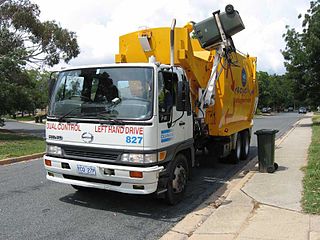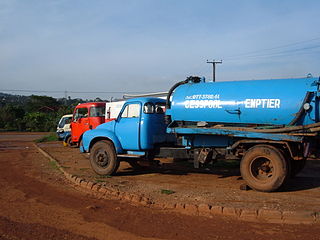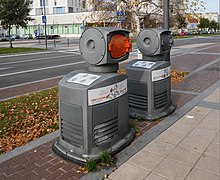
Pneumatic tubes are systems that propel cylindrical containers through networks of tubes by compressed air or by partial vacuum. They are used for transporting solid objects, as opposed to conventional pipelines which transport fluids. In the late 19th and early 20th centuries, pneumatic tube networks gained acceptance in offices that needed to transport small, urgent packages, such as mail, other paperwork, or money, over relatively short distances, within a building or, at most, within a city. Some installations became quite complex, but have mostly been superseded. However, they have been further developed in the 21st century in places such as hospitals, to send blood samples and the like to clinical laboratories for analysis.

A garbage truck is a truck specially designed to collect municipal solid waste and transport it to a solid waste treatment facility, such as a landfill, recycling center or transfer station. In Australia they are commonly called rubbish trucks, or garbage trucks, while in the U.K. dustbin lorry, rubbish lorry or bin lorry is commonly used. Other common names for this type of truck include trash truck in the United States, and refuse truck, dustcart, junk truck, bin wagon or bin van elsewhere. Technical names include waste collection vehicle and refuse collection vehicle (RCV). These trucks are a common sight in most urban areas.
Articles related to waste management include:
Pay as you throw (PAYT) is a usage-pricing model for disposing of municipal solid waste. Users are charged a rate based on how much waste they present for collection to the municipality or local authority.

Waste collection is a part of the process of waste management. It is the transfer of solid waste from the point of use and disposal to the point of treatment or landfill. Waste collection also includes the curbside collection of recyclable materials that technically are not waste, as part of a municipal landfill diversion program.
The Roosevelt Island Operating Corporation (RIOC) is a New York State public-benefit corporation responsible for developing Roosevelt Island, a small island in the East River that is part of the New York City borough of Manhattan.

A waste container, also known as a dustbin, rubbish bin, trash can, and garbage can, among other names, is a type of container intended to store waste that is usually made out of metal or plastic. The words "rubbish", "basket" and "bin" are more common in British English usage; "trash" and "can" are more common in American English usage. "Garbage" may refer to food waste specifically or to municipal solid waste in general.

Kerbside collection or curbside collection is a service provided to households, typically in urban and suburban areas, of collecting and disposing of household waste and recyclables. It is usually accomplished by personnel using specially built vehicles to pick up household waste in containers that are acceptable to, or prescribed by, the municipality and are placed on the kerb.

The Zabbaleen is a word which literally means "garbage people" in Egyptian Arabic. The contemporary use of the word in Egyptian Arabic is to mean "garbage collectors". In cultural contexts, the word refers to teenagers and adults who have served as Cairo's informal garbage collectors since approximately the 1940s. The Zabbaleen are also known as Zarraba, which means "pig-pen operators." The word Zabbalīn came from the Egyptian Arabic word zebāla which means "garbage".

Waste sorting is the process by which waste is separated into different elements. Waste sorting can occur manually at the household and collected through curbside collection schemes, or automatically separated in materials recovery facilities or mechanical biological treatment systems. Hand sorting was the first method used in the history of waste sorting. Waste can also be sorted in a civic amenity site.

A vacuum sewer or pneumatic sewer system is a method of transporting sewage from its source to a sewage treatment plant. It maintains a partial vacuum, with an air pressure below atmospheric pressure inside the pipe network and vacuum station collection vessel. Valves open and reseal automatically when the system is used, so differential pressure can be maintained without expending much energy pumping. A single central vacuum station can collect the wastewater of several thousand individual homes, depending on terrain and the local situation.
Recycling in the Netherlands is under the responsibility of local authorities. Different localities implement different systems, and also within a municipality there can be multiple regimes. Municipalities publish a yearly calendar of the pickup dates and the addresses of the waste separation and recycling stations.
Waste management in Japan today emphasizes not just the efficient and sanitary collection of waste, but also reduction in waste produced and recycling of waste when possible. This has been influenced by its history, particularly periods of significant economic expansion, as well as its geography as a mountainous country with limited space for landfills. Important forms of waste disposal include incineration, recycling and, to a smaller extent, landfills and land reclamation. Although Japan has made progress since the 1990s in reducing waste produced and encouraging recycling, there is still further progress to be made in reducing reliance on incinerators and the garbage sent to landfills. Challenges also exist in the processing of electronic waste and debris left after natural disasters.

Recology, formerly known as Norcal Waste Systems, is a waste management company headquartered in San Francisco, California. The company collects and processes municipal solid waste, reclaiming reusable materials. The company also operates transfer stations, materials recovery facilities (MRFs), a number of landfills, and continues to spearhead renewable energy projects. Recology is the largest organics compost facility operator by volume in the United States.

A vacuum truck, vacuum tanker, vactor truck, vactor, vac-con truck, vac-con is a tank truck that has a pump and a tank. The pump is designed to pneumatically suck liquids, sludges, slurries, or the like from a location into the tank of the truck. The objective is to enable transport of the liquid material via road to another location. Vacuum trucks transport the collected material to a treatment or disposal site, for example a sewage treatment plant.
The San Francisco Mandatory Recycling and Composting Ordinance is a local municipal ordinance requiring all persons located in San Francisco to separate their recyclables, compostables and landfilled trash and to participate in recycling and composting programs. Passed by the San Francisco Board of Supervisors in 2009, it became the first local municipal ordinance in the United States to universally require source separation of all organic material, including food residuals.

In Disney theme parks, the utilidor system is a system of some of the world's largest utility tunnels, mainly for Walt Disney World's Magic Kingdom in Florida. The utilidors, short for utility corridors, are a part of Disney's "backstage" (behind-the-scenes) area. They allow Disney employees to perform park support operations, such as trash removal, and for costumed characters to quickly reach their destinations on the surface out of the sight of guests to avoid ruining the illusion that is being created.

Pennsylvania is a northeastern commonwealth located in the United States of America. It was one of the 13 original colonies. Pennsylvania is home to a population of 12,802,503 individuals and various different types of environments. Pennsylvania is known for its many hills, plateaus, mountains and valleys. In fact, Pennsylvania is 50 percent forest land with the only lowlands located in the southeast.

Taiwan has one of the most efficient recycling programs globally, with a 55% collection rate from households and businesses and a 77% collection rate from industrial waste in 2019. Taiwan’s high recycling rates are unattainable in most countries due to Taiwanese geographical advantages along with efficient waste processing technologies and systems.

New York City's waste management system is a refuse removal system primarily run by the New York City Department of Sanitation (DSNY). The department maintains the waste collection infrastructure and hires public and private contractors who remove the city's waste. For the city's population of more than eight million, The DSNY collects approximately eleven thousand tons a day of garbage, including compostable material and recycling.















